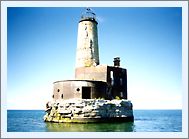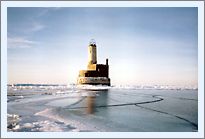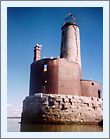|
Historical
Information

After a number of groundings in the
early 1820's, mariners began petitioning the Federal Government to
construct an aid to navigation on Waugoshance Shoal. While the construction of underwater cribs had been attempted with
success on the East Coast, the relatively short shipping seasons and
thick winter ice of northern Lake Michigan appeared to make such an
undertaking a daunting challenge.
As an interim measure, the wooden vessel
LOIS MCLANE, which had been converted into a
lightship, was placed on Waugoshance Shoal in 1832, thus taking her place in history as the first lighthouse to serve on all the Great
Lakes.
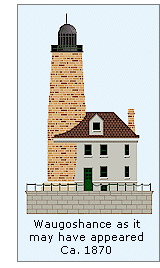 In 1850, the decision was made to
construct a more permanent light on the shoal, and work began with the
construction of a timber crib on St. Helena Island. The crib was then
towed to Waugoshance and sunk in place through the addition of large
rocks. A cofferdam was then constructed around the crib, and the water
pumped out, exposing the surface of the shoal. Cement was then applied
to the surface of the shoal in order to create a smooth, flat base on
which to build. Pre-dressed limestone slabs, each weighing close to
twelve tons were set on the cement foundation, and bolted to the cement
and each other. Finally, a circle of solid masonry was laid, enlarging
the crib to a size of forty-eight by sixty-six feet. In 1850, the decision was made to
construct a more permanent light on the shoal, and work began with the
construction of a timber crib on St. Helena Island. The crib was then
towed to Waugoshance and sunk in place through the addition of large
rocks. A cofferdam was then constructed around the crib, and the water
pumped out, exposing the surface of the shoal. Cement was then applied
to the surface of the shoal in order to create a smooth, flat base on
which to build. Pre-dressed limestone slabs, each weighing close to
twelve tons were set on the cement foundation, and bolted to the cement
and each other. Finally, a circle of solid masonry was laid, enlarging
the crib to a size of forty-eight by sixty-six feet.
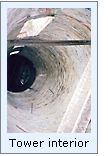 Atop this crib, the brick tower rose to
a height of seventy-six feet. Twenty feet in diameter at the base, with
walls five feet in thickness, the tower tapered to a diameter of twelve
feet at its uppermost, at which point the walls tapered to two feet in
thickness. At its completion in 1851, the tower was crowned with a large
"bird cage" style lantern room, one of only three lighthouses
to be equipped with this style of lantern room in all of the Great
Lakes. The lantern was equipped with the first Fourth Order Fresnel lens
to be installed in any Great Lakes lighthouse. Displaying a fixed
white light, varied by a white flash every 45 seconds, the light
impressive French optic was visible to mariners at a distance of sixteen
miles. Atop this crib, the brick tower rose to
a height of seventy-six feet. Twenty feet in diameter at the base, with
walls five feet in thickness, the tower tapered to a diameter of twelve
feet at its uppermost, at which point the walls tapered to two feet in
thickness. At its completion in 1851, the tower was crowned with a large
"bird cage" style lantern room, one of only three lighthouses
to be equipped with this style of lantern room in all of the Great
Lakes. The lantern was equipped with the first Fourth Order Fresnel lens
to be installed in any Great Lakes lighthouse. Displaying a fixed
white light, varied by a white flash every 45 seconds, the light
impressive French optic was visible to mariners at a distance of sixteen
miles.
Exposed as it was to the full fury of
Lake Michigan and to the great breaking fields of ice every spring, the
crib began to deteriorate. Reacting to this deterioration in 1865, the
Lighthouse Board appropriated the funds required to make the repairs
necessary to ensure the station's continued structural integrity, and
quickly completed the work.
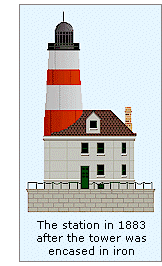 While the repairs of 1865 were
considerable in their scope, they were no match for the relentless fury
of the lake, and by the late 1880's the crib and the soft brick of the
tower had once again deteriorated to the point where major repairs were
needed. While the repairs of 1865 were
considerable in their scope, they were no match for the relentless fury
of the lake, and by the late 1880's the crib and the soft brick of the
tower had once again deteriorated to the point where major repairs were
needed.
In order to effect the most nearly
permanent repair possible with the technology available, the decision
was made encase the entire structure in 3/8" thick boiler plate,
riveted together, and leaving sufficient space between the iron and the
masonry for filling with a layer of concrete. Bids were let for the
contract on July 1, 1883, Buhl Iron Works Company of Detroit was the
lowest bidder at $23,000, and was thus awarded the contract for the
work.
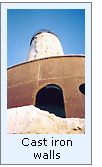 Measurements were taken of the entire
Waugoshance structure, and each piece of the iron armor was custom bent
and punched at the Buhl shops. By the time the components were ready for
shipment to the site, over 24,000 rivet holes had been punched in the
form-fitting iron skin. All-told, 136,000 pounds of iron, 120 barrels of
Portland cement, 350 barrels of sand, 20,000 bricks, fifty barrels of
lime, two forty-two foot long boilers, two fog signal engines, and all
the hardware and supplies for the crew were loaded-up on vessels and
shipped to the site. Measurements were taken of the entire
Waugoshance structure, and each piece of the iron armor was custom bent
and punched at the Buhl shops. By the time the components were ready for
shipment to the site, over 24,000 rivet holes had been punched in the
form-fitting iron skin. All-told, 136,000 pounds of iron, 120 barrels of
Portland cement, 350 barrels of sand, 20,000 bricks, fifty barrels of
lime, two forty-two foot long boilers, two fog signal engines, and all
the hardware and supplies for the crew were loaded-up on vessels and
shipped to the site.
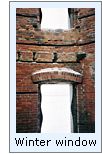 Inclement weather hampered the entire
project, and every blow made working on the precarious scaffolds erected
around the structure extremely dangerous, and drove the crew from the
site to take refuge in Mackinaw City. A two-week period went by when
vessels were unable to approach the work site, and without the necessary
supplies, the work ground to a halt. Sickness was rampant on the pier,
and many of the crew had to be taken off and replaced. Amazingly,
against such odds work was completed in early October, with the painting
of alternating horizontal red and white bends to increase the station's
effectiveness as a daymark, and the project was completed three weeks
ahead of schedule.
Inclement weather hampered the entire
project, and every blow made working on the precarious scaffolds erected
around the structure extremely dangerous, and drove the crew from the
site to take refuge in Mackinaw City. A two-week period went by when
vessels were unable to approach the work site, and without the necessary
supplies, the work ground to a halt. Sickness was rampant on the pier,
and many of the crew had to be taken off and replaced. Amazingly,
against such odds work was completed in early October, with the painting
of alternating horizontal red and white bends to increase the station's
effectiveness as a daymark, and the project was completed three weeks
ahead of schedule.
By the end of the 1880's the size of
the vessels plying the Great Lakes was increasing. These larger vessels,
drawing more water, began entering the Straits of Mackinac at a point
approximately four miles further North, in an area of deeper water. The
White Shoal reef sat perilously close to this new passage, and in 1878, the Chicago Lumbering Company
stationed an old derelict
vessel over White Shoal to warn mariners of the danger lurking a few
feet beneath the waves.
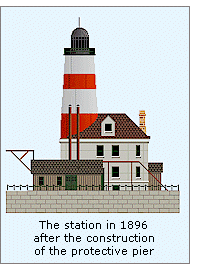 Pounded by waves and the annual freeze-thaw cycle, by the early 1890's
the crib and pier supporting the Waugoshance light was deteriorating
rapidly, and with the tower in imminent danger of toppling, the
Lighthouse Board requested funding from Congress to completely rebuild
and enlarge the pier. Congress responded favorably, and on May 4, 1896
the lighthouse tender WARRINGTON, unloaded a working party and
materials at St. Helena Island, which was to serve as the base of
operations for the project. A work camp, storage area, docks and a
stone-crusher were quickly established, and preparations began. Pounded by waves and the annual freeze-thaw cycle, by the early 1890's
the crib and pier supporting the Waugoshance light was deteriorating
rapidly, and with the tower in imminent danger of toppling, the
Lighthouse Board requested funding from Congress to completely rebuild
and enlarge the pier. Congress responded favorably, and on May 4, 1896
the lighthouse tender WARRINGTON, unloaded a working party and
materials at St. Helena Island, which was to serve as the base of
operations for the project. A work camp, storage area, docks and a
stone-crusher were quickly established, and preparations began.
The WARRINGTON delivered the work party
to the shoal on May 21, and work on the shoal began in earnest. through
May, 27,000 board feet of old lumber framing timber and 33 cords of
stone was removed from the old crib and pier. In June 155,000 board feet
of old timber were removed, and 1,712 feet of new timber
installed. Over the summer, the steel casings for the new enlarged pier
were set up, and 205 cords of ballast stone were poured into the
structure, and 65 yards of concrete were poured. Unfortunately, over
most of the summer, many weeks were lost while the tender and work crew
waited-out passing storms back at camp on St. Helena.
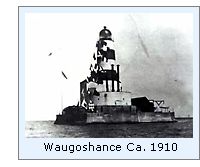 Finally, on October 10, the work was completed, and the crews
left Waugoshance to the keepers and the birds. Finally, on October 10, the work was completed, and the crews
left Waugoshance to the keepers and the birds.
In October
1891 the Lighthouse Board stationed Lightship LV56 on White Shoal. Built
earlier that year by the Blythe-Craig Shipbuilding Company in Toledo,
she was one of three identical vessels commissioned in that year to
serve in the area of the Straits.
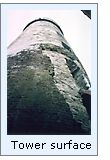 The massive work of 1896 was not to be
long lived, as the tender Alice M. Gill arrived at the shoal in 1902,
and assisted a working party in the the reconstruction of the west
corner of the protecting pier, which had begun deteriorating
significantly. In an attempt to protect the pier from the destructive
force of the waves, this corner of the pier was filled-in with concrete
and ballast stone, and faced with 3/8" iron plating. The massive work of 1896 was not to be
long lived, as the tender Alice M. Gill arrived at the shoal in 1902,
and assisted a working party in the the reconstruction of the west
corner of the protecting pier, which had begun deteriorating
significantly. In an attempt to protect the pier from the destructive
force of the waves, this corner of the pier was filled-in with concrete
and ballast stone, and faced with 3/8" iron plating.
As a result of the ferocity of spring
and fall storms, the viable working season for lightships was a few
months shorter than that of lighthouses. Thus, in order to provide
maximum protection in the area, the decision was made to establish a permanent light
station on White Shoal, and construction was begun in 1908 and completed in 1910.
With the commissioning of the larger
and more powerful White Shoals light a few miles to the north,
Waugoshance Light became redundant, and was thus decommissioned in 1912.
The Waugoshance Light sat undisturbed by all but the forces of nature until the early 1940s, when with the
breakout of World War II, hotshot flyboys decided that the old lighthouse would
make a perfect target for bombing practice during their military pilot training. Apparently a number of missiles hit their target, as a massive
fire broke out on the structure, completely gutting the interior of the
tower and keepers dwelling of anything combustible.
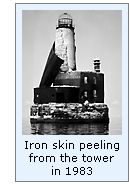 In early 1983, the bullet-riddled
boilerplate shell began to peel from the structure, once again exposing
the soft brick to the elements. Over the intervening years, the entire
casing has fallen into the lake. Anything of
value remaining after the strafing exercises has been either removed or
destroyed by vandals. The copper roof of the birdcage lantern is
long-gone. Even the heavy cast iron stairs within the tower having been
taken by some enterprising lawbreaker with no respect for history. In a
perverse sense, the removal of the stairs has turned out to be somewhat
of a blessing, for without the stairs, nobody has yet been able to scale
the tower and destroy what remains of the lantern room. In early 1983, the bullet-riddled
boilerplate shell began to peel from the structure, once again exposing
the soft brick to the elements. Over the intervening years, the entire
casing has fallen into the lake. Anything of
value remaining after the strafing exercises has been either removed or
destroyed by vandals. The copper roof of the birdcage lantern is
long-gone. Even the heavy cast iron stairs within the tower having been
taken by some enterprising lawbreaker with no respect for history. In a
perverse sense, the removal of the stairs has turned out to be somewhat
of a blessing, for without the stairs, nobody has yet been able to scale
the tower and destroy what remains of the lantern room.
This same year, the Coast Guard surveyed
the structure, and recommended that it be declared surplus and
demolished in order to prevent injury.
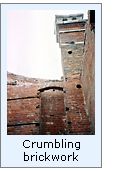 In 2000, the Waugoshance Lighthouse
Preservation Society was formed, with it's charter being the eventual
complete restoration of the structure. The Coast Guard has authorized the
W.L.P.S to raise the funds to secure the presently standing structure while a long term lease is drawn up, giving the Society temporary ownership, for the restoration process.
The Society has a huge task ahead of it, and will need all of the help
they can get in order to successfully carry off the restoration. In 2000, the Waugoshance Lighthouse
Preservation Society was formed, with it's charter being the eventual
complete restoration of the structure. The Coast Guard has authorized the
W.L.P.S to raise the funds to secure the presently standing structure while a long term lease is drawn up, giving the Society temporary ownership, for the restoration process.
The Society has a huge task ahead of it, and will need all of the help
they can get in order to successfully carry off the restoration.
Meanwhile, Waugoshance Light silently
waits, guarding the shoal as it has for almost one hundred and fifty years.
While obviously bedraggled and sickly, the pride of this once majestic
structure can still be sensed.

Keepers of this Light

Click Here to see a complete listing of
all Waugoshance Light keepers compiled by Phyllis L. Tag of Great Lakes
Lighthouse Research.

Seeing this Light

We do not expect to have access to a seaworthy vessel until 2002, and thus will
likely not be able to visit this light until then.

Finding this
Light

Sheplers Ferry Service out of Mackinaw City offers a number of
lighthouse cruises during the summer season. Their "Westward
Tour" includes passes by White Shoal, Grays Reef, Waugoshance and
St. Helena Island. For schedules and rates for this tour, visit their
website at: www.sheplerswww.com
or contact them at:
PO Box 250
Mackinaw City, MI 49701
Phone (800) 828-6157

Contact
information

The Waugoshance Lighthouse Preservation Society maintains a website
chronicling their goals, needs and current activities at www.waugoshance.org
They can also be contacted at the following address:
Waugoshance Lighthouse
Preservation Society
P.O. BOX 1061
Mackinaw City, MI 49701

Reference Sources

Annual reports of the Lighthouse
Board, various, 1859 - 1912
Inventory of Historic Light Stations, National Parks Service,
1994
Lighthouse Board Annual Reports - 1890 though 1912
Detroit Free Press, Arrival of the last of the working party in
Detroit, 10/13/1883
Great Lakes Cruiser magazine, Jack Edwards, 10/1994
Photographs courtesy of Jeff Cronk & Chris West.
Great Lakes Coast Pilot, NOAA, 1999
Keeper listings for this light appear
courtesy of Great
Lakes Lighthouse Research
|
